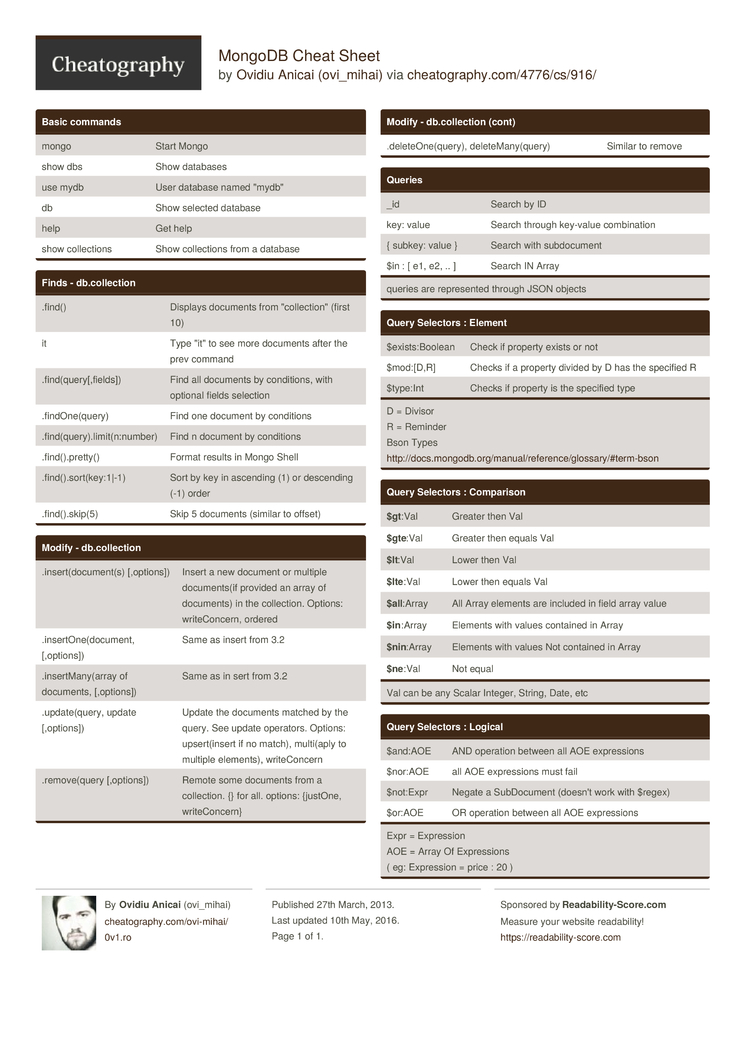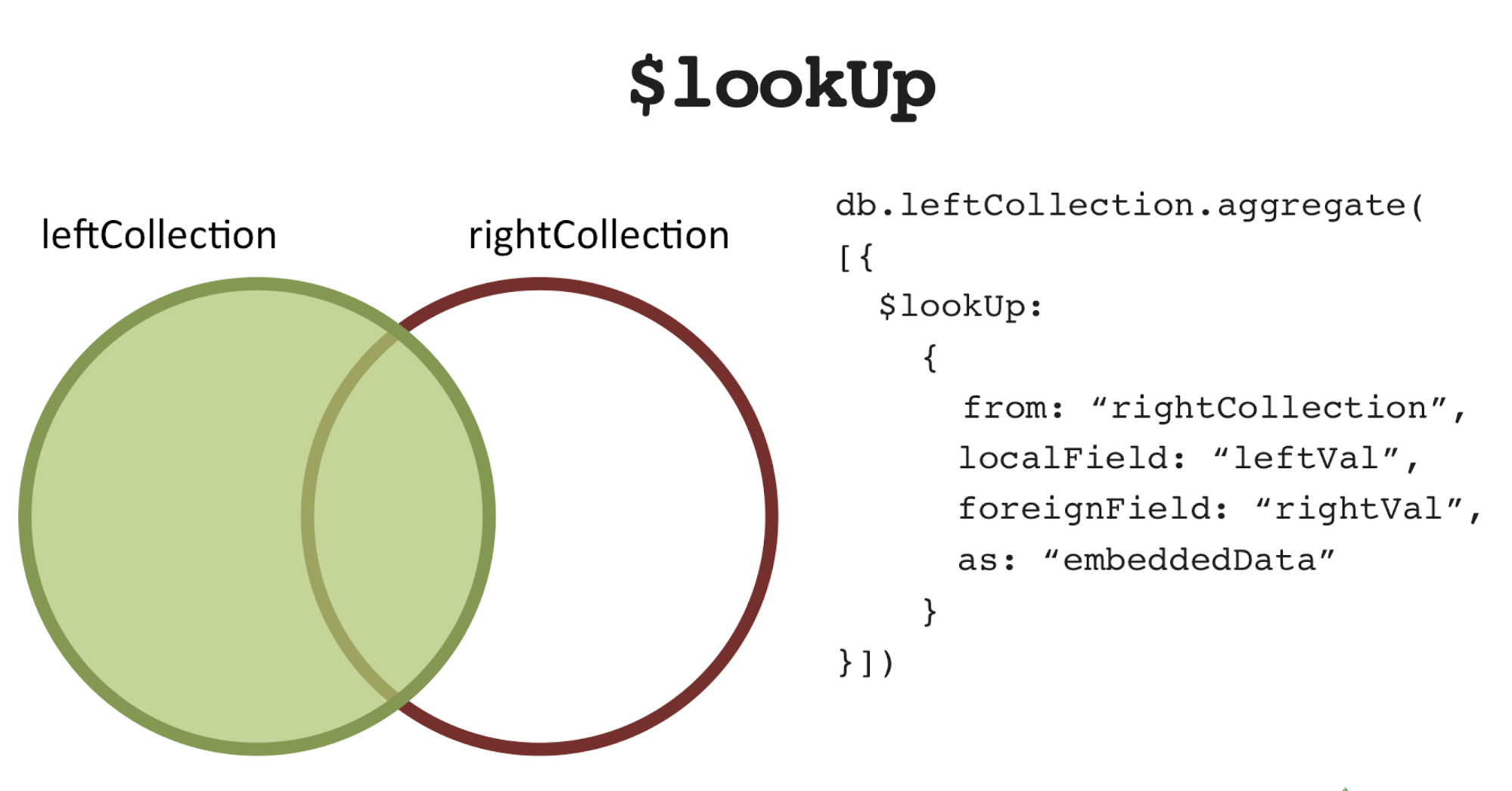- Mongodb Query Cheat Sheet Download
- Mongodb Query Syntax
- Mongodb Query Cheat Sheet
- Mongodb Query Injection Cheat Sheet
- Mongodb Compass Query Cheat Sheet
This article provides a one-stop-shop for all the administration related queries, help related commands, and the basic CRUD operations that can be done on collections on a MongoDB database. As mentioned earlier during the introduction of the article, this is written for the latest stable release of MongoDB (version v3.4.7). # mongodb # database # nosql Kanthaliya Jul 4, 2020 ・ Updated on Oct 19, 2020 ・1 min read Here are few less used but important Mongodb queries I use now and then. MongoDb Cheat Sheets. GitHub Gist: instantly share code, notes, and snippets.
MongoDB is a popular NoSQL database that allows unauthenticated access by default.
Free macos apps every mac user should have. Regardless of the user’s authentication database, Mongo always stores user information in admin. Focus t25 program download.
MongoDB stores all user information, including name, password, and the user’s authentication database, in the system.users collection in the admin database.
See centralized-user-data and system-users-collection.
When you create a user and grant that user access to a single database (aka their authentication database) then that information can only be stored in the admin database.
So, it’s not really a question of “best practice”; storing user details in admin is MongoDB’s choice, as implemented by their user management commands.
Update in response to this comment:
Ok, so the users are always located in the admin db, but I may also add “duplicates” to the other dbs? Maybe the question should be whether there any advantage in adding users to the other “non admin” dbs?
If you intend to have a single user with access to multiple databases then create a single user with roles in each of those databases rather than creating that user multiple times i.e. once in each of those databases. For example:
Create initial admin user
Sharded Cluster with enforced authentication
Create:
- a cluster-wide admin user
- a replica set specific admin user
Cluster-wide Admin
Replica Set Admin (a.k.a shard local)
Enable authentication in the mongos configuration
Connect to all replica set member nodes
Authenticate and check that the admin users exist
Log in
Rename collections
Copy Collection
Check replication set status
Backup/Restore
Documents
Admin commands
TLS 1.2 for Mongo Routers
To protect your application’s database connection enable TLS on the mongo routers as follows. Note that your mongo driver configuration needs to trust the CA certificate and enable transport encryption with ssl=true.
Mongodb Query Cheat Sheet Download
Rolling Update/Cluster Patching
Maintenance (startup in reverse order):
Replication Concept
- write operations go to the primary node
- all changes are recorded into operations log
- asynchronous replication to secondary
- secondaries copy the primary oplog
- secondary can use sync source secondary*
- automatic failover on primary failure
*settings.chainingAllowed (true by default)
Replica set oplog
- special capped collection that keeps a rolling record of all operations that modify the data stored in the databases
- idempotent
default oplog size (for Unix and Windows systems):
Storage Engine Default Oplog Size Lower Bound Upper Bound In-memory 5% of physical memory 50MB 50GB WiredTiger 5% of free disk space 990MB 50GB MMAPv1 5% of free disk space 990MB 50GB

Deployment
- start each server with config options for replSet
/usr/bin/mongod --replSet 'myRepl' - initiate the replica set on one node -
rs.initialize() - verify the configuration -
rs.conf() - add the rest of the nodes -
rs.add()on the primary noders.add('node2:27017'),rs.add('node3:27017') - check the status of the replica set -
rs.status()
Sharding

Components
- shard/replica set - subset of the sharded data
- config servers - metadata and config settings
- mongos - query router, cluster interface
sh.addShard('shardName')
Shards
- contains subset of sharded data
- replica set for redundancy and HA with odd number of voting members
- primary shard
- don’t shard collections if dataset fits into single server
- –shardsvr in config file (port 27018)
- every xxx has a primary shard per database
- all non-shared collections will reside on primary shard
Shard keys (and limitations)
Mongodb Query Syntax
- shard keys are immutable with max size of 512 bytes (can not be updated/changed)
- must be ascending indexed key or indexed compound keys that exists in every document in the collection
- cannot be multikey index, a text index or a geospatial index
- update operations that affect a single document must include the shard key or the _id field
- no option for sharding if unique indexes on other fields exist
- no option for second unique index if the shard key is unique index
- ranged sharding may not distribute the data evenly
- hashed sharding distributes the data randomly
Config servers
- config servers as replica set (only 3.4)
- stores the metadata for sharded cluster in
configdatabase - authentication configuration information in
admindatabase - holds balancer on Primary node (>= 3.4)
- –configsvr in config file (port 27019)
mongos
- caching metadata from config servers
- routes queries to shards
- no persistent state
- updates cache on metadata changes
- holds balancer (mongodb <= 3.2)
- mongos version 3.4 can not connect to earlier mongod version
Sharding collection
Mongodb Query Cheat Sheet
| Step | Command |
|---|---|
| Enable sharding on database | sh.enableSharding('users') |
| Shard collection | sh.shardCollection('users.history', { user_id : 1 } ) |
| Shard key - indexed key that exists in every document | range basedsh.shardCollection('users.history', { user_id : 1 } )hashed based sh.shardCollection( 'users.history', { user_id • 'hashed' } ) |
output
Mongodb Query Injection Cheat Sheet

Mongodb Compass Query Cheat Sheet
markdown source
